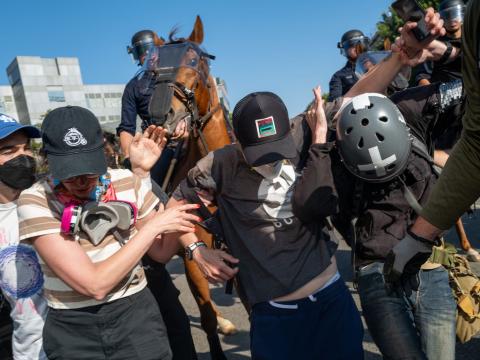I first became aware of STO in the late 1980s, a few years after the organization disbanded. Compared with most of the left groups I was aware of, STO seemed like a breath of fresh air. Here was a Marxist organization that promoted both revolutionary politics and genuine open debate, and that combined practical work with nuanced, sophisticated analyses of major issues like white supremacy and fascism. Whatever its failings, I knew this was a model worth learning from.
In Truth and Revolution, Mike Staudenmaier writes about how STO developed the dialectics study to help strengthen and equalize theoretical understanding within the group. I took the dialectics course in 1989, taught by two former STO members, and I remember them emphasizing that if you want people to be able to provide constructive leadership and make good political decisions, then people have to be able to think for themselves. The course format itself reflected this, in that our teachers welcomed suggestions from participants for changes to the curriculum and encouraged all of us to take turns leading the discussions. The dialectics study and related STO readings had a big impact on me. They didn't make me a sophisticated thinker in terms of high theory, but they helped me develop some practical analytical tools, based especially on treating contradiction as a dynamic process and a crucial historical reality.
The analysis of white skin privilege, which was central to STO politics from beginning to end, highlights what was distinctive about STO's theoretical approach. Lots of leftists and liberals have embraced the white skin privilege concept over the past forty-odd years, but too many of them have interpreted it to mean that white people, including white workers, are simply bought off, co-opted into being supporters of the status quo. To me, the key thing about STO's take on this issue is that it treats white workers' situation as contradictory. STO said that white workers have a material stake in the system of racial oppression but are still part of an exploited class that has the potential to make a revolution. And this contradictory situation embodies part of the basic contradiction of capitalism, which is internal to the working class itself.
STO's analysis of fascism is one of its contributions that has most directly affected my own work. Mike's book traces how, in the late 1970s, STO shifted from a conventional Marxist view of fascism (as the last defense of capitalism when bourgeois democracy fails), to an understanding that fascism has its own dynamic and an important degree of autonomy from capitalist control; that it has a genuine revolutionary, anti-capitalist dimension; and that it has the potential to gain a mass following, specifically within the white working class. Here again, the analysis hinges on the idea of contradiction, specifically, fascism's contradictory relationship with the capitalist system. STO came to regard fascist movements and state repression as threats that were interrelated but also distinct and increasingly at odds with each other. By the early 1980s, STO was treating anti-fascist organizing as an area of strategic importance in its own right. Within the framework of building a defensive united front against fascism, STO promoted a militant approach that rejected reliance on the state.
One other area of STO's legacy that I want to highlight concerns the politics of solidarity.
Truth and Revolution details the organization's work in support of national liberation and “Third World” revolutionary groups, especially between the mid 1970s and early eighties. Parts of this account are not very flattering. For example, STO defended the Khomeini government as a bulwark against US imperialism, and “while it was quite willing to criticize other anti-imperialist organizations…for subordinating themselves to the organizational or ideological outlook of various revolutionary nationalist groups, in practice STO all too often did the exact same thing…” (p. 320). Yet the former STO members I met in the late 1980s were vividly aware of these mistakes. While recognizing that white (and US) privilege was a factor that could not be wished away, they were sharply critical of the model that said white leftists should simply “take leadership” from Third World revolutionaries, an issue I was struggling to untangle at the time. One of them recounted a situation where STO received opposite instructions from a black nationalist group and a Puerto Rican group they were working with closely, which underscored the point that they had to figure it out for themselves.
STO made many contributions and had many shortcomings, and I think Truth and Revolution does an excellent job of highlighting both in a fair and constructive way. But from the standpoint of learning from its legacy, it seems to me that STO's strengths are much more distinctive than its weaknesses. Many of the problems that Mike discusses—the informal hierarchy, the imbalance between men's and women's participation, the millenarianism leading to burnout, the failure to stick with one strategic direction for more than a few years, the failure to grow—were and are common problems on the left and beyond the left. That doesn't mean we should minimize or excuse them, but rather that we probably need to look beyond the specifics of STO's story to understand and avoid these problems. By contrast, STO's contributions to revolutionary theory, its efforts to promote critical thinking as a necessary complement to practical work, its fundamental humility regarding its own role in building a revolutionary mass movement—these were and are much more rare.






Comments